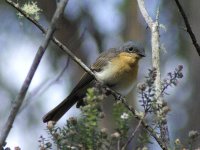Hi folks , calling on your collective expertise once more to help ID a bird - at first i thought it was a juvenile robin (we have flame robins and scarlet here) but it is too big and not the right colour for the varieties I have encountered to date -searched the various references but just cannot pin it down to my satisfaction - I think it could be one ofthe flycatcher variety?
Any help appreciated
thanks
Ron Co
http://www.flickr.com/photos/ron-alenka/
Any help appreciated
thanks
Ron Co
http://www.flickr.com/photos/ron-alenka/




